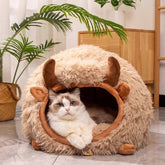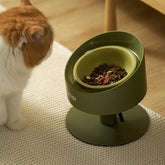Your Stress-Free Guide to Switching Your Cat's Litter Box

Ah, the litter box—the unsung hero of cat ownership. It’s where your furry friend does their business, and let’s be honest, it’s not the most glamorous part of being a cat parent. But there comes a time when you might need to change that trusty box for something new. Whether it’s due to wear and tear, your cat’s evolving preferences, or just a desire for a fresh start, switching litter boxes can be a bit tricky. Fear not! We’ve got you covered with this guide to make the process as smooth as a cat's purr.
Why You Might Need to Change Cat Litter Boxes
There are several reasons why you might find yourself in the market for a new litter box:
Wear and Tear
Just like your favorite pair of shoes, litter boxes can wear out over time. Scratches, cracks, and odors can accumulate, making the box less appealing for your kitty.
Health Issues
If your cat has developed mobility issues or arthritis, they may struggle with high-sided boxes. A lower entry point could make all the difference in keeping them comfortable.
Changing Preference
Cats are notoriously picky creatures. If your feline friend has suddenly decided they no longer like their current box (thanks to some mysterious feline logic), it might be time for an upgrade.
Aesthetic Upgrades
Let’s face it—some litter boxes are just plain ugly. If you’re looking to improve your home decor while still providing a functional space for your cat, a stylish litter box might be in order.
Multiple Cats
If you’ve added a new furry family member or if your household has grown, you may need more than one litter box to accommodate everyone’s needs.

How to Do the Switch: Handling the Old One and Getting the New One Ready
Now that you’ve decided it’s time for a change, let’s talk about how to make that switch without causing chaos in your home.
Step 1: Choose the Right New Box
Before you do anything drastic, pick out a new litter box that suits your cat's needs. Consider factors like size, entry height, and whether they prefer an open or covered design. Check out this article which might help you with making the best choice fro your cat.
Step 2: Prepare the New Box
Once you’ve got your new litter box, it’s time to get it ready for action:
-
Clean It Thoroughly: Give the new box a good wash with mild soap and water before introducing it to your cat. This will remove any manufacturing residue and ensure it's squeaky clean.
- Add Familiar Litter: Use the same type of litter your cat is accustomed to. If you want to switch types later on, do so gradually after they’ve adjusted.
Step 3: Handle the Old Box
When it comes to dealing with the old box:
-
Clean It Up: If you plan on keeping it as a backup or donating it, give it a thorough cleaning first.
-
Dispose of It Properly: If it's beyond saving (think cracked and stained), dispose of it responsibly—no one wants an old litter box lurking in their garage!

Ensuring a Smooth Transition
Transitioning from one litter box to another doesn’t have to be stressful for either party involved. Here are some tips to make sure everything goes off without a hitch:
Gradual Introduction
Instead of abruptly removing the old box, place the new one next to it. This way, your cat can explore their new throne at their own pace while still having access to their familiar spot.
Positive Reinforcement
Encourage your kitty to use their new box by offering treats or praise when they do so. Cats respond well to positive reinforcement—who doesn’t love a little bribery?
Maintain Cleanliness
Keep both boxes clean during the transition period. Scoop daily and change litter regularly; this will encourage your cat to use the new box instead of reverting back to the old one.
Monitor Behavior
Keep an eye on how your cat interacts with the new box. Are they using it? Sniffing at it suspiciously? If they seem hesitant, don’t panic—give them time!

Monitoring if the New Litter Box is Suitable
After you've made the switch, it's crucial to monitor how well your cat adjusts to their new bathroom setup:
Watch Their Usage
Is your cat using the new litter box consistently? If they’re avoiding it altogether or showing signs of distress (like excessive meowing or scratching), something might be off.
Check for Accidents
If accidents start happening outside of the litter box, this could indicate that something isn’t right—whether it's discomfort with the new box or an underlying health issue.
Observe Their Comfort Level
Pay attention to how comfortable your cat seems when using their new box. Are they relaxed? Or do they look anxious? A content kitty will often exhibit calm body language while using their litter area.
Consult Your Vet if Needed
If problems persist despite all efforts—like refusal to use the new box or signs of distress—it might be worth consulting your veterinarian for advice on potential health issues or behavioral concerns.

Conclusion
Transitioning to a new litter box doesn't have to be a cat-astrophe! With a bit of strategy and empathy for your feline companion, you can orchestrate a seamless switch that leaves both you and your kitty purring with contentment.
Remember: patience is key! Cats can be creatures of habit, but with love and encouragement (and maybe some treats), they'll soon feel right at home in their new bathroom setup. So go ahead—make that switch! Your furry friend will thank you for it (even if they don’t show it). Happy scooping!























